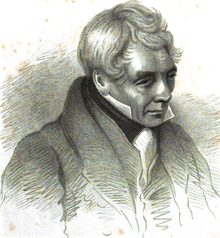Peter Nicholson | |
|---|---|
 Engraved portrait of Nicholson from the frontispiece of his Guide to Railway Masonry | |
| Born | 20 July 1765 Prestonkirk, East Lothian |
| Died | 18 June 1844 (aged 78) Carlisle, Cumbria |
| Nationality | British |
| Education | Parish school (three years only), mostly self-taught[1] |
| Occupation | Engineer |
| Spouse(s) | Jane (d. 1832);[2] re-married |
| Children | Michael Angelo Nicholson (c. 1796–1841), by Jane; Jessie Nicholson (m. Bowen), Jamieson T. Nicholson, both by 2nd wife[2] |
| Parent | [father was a stonemason] |
| Engineering career | |
| Discipline | Architect, mathematician, structural engineer |
| Projects | Carlton Place, Glasgow Ardrossan town plan |
| Significant design | The centrolinead The cyclograph |
| Significant advance | The helicoidal skew arch |
Peter Nicholson (20 July 1765 – 18 June 1844) was a Scottish architect, mathematician and engineer. Largely self-taught, he was apprenticed to a cabinet-maker but soon abandoned his trade in favour of teaching and writing. He practised as an architect but is best remembered for his theoretical work on the skew arch (he never actually constructed one himself), his invention of draughtsman's instruments, including a centrolinead and a cyclograph, and his prolific writing on numerous practical subjects.
- ^ Anderson, William (1867). The Scottish Nation. Vol. III (Mac–Zet). Edinburgh: A. Fullarton & Co. pp. 250–251.
- ^ a b T., O. (1844). Laxton, William (ed.). "Memoir of the Late Peter Nicholson, Architect". The Civil Engineer and Architect's Journal, Scientific and Railway Gazette. VII. London: Groombridge & Sons, J. Weale: 425.